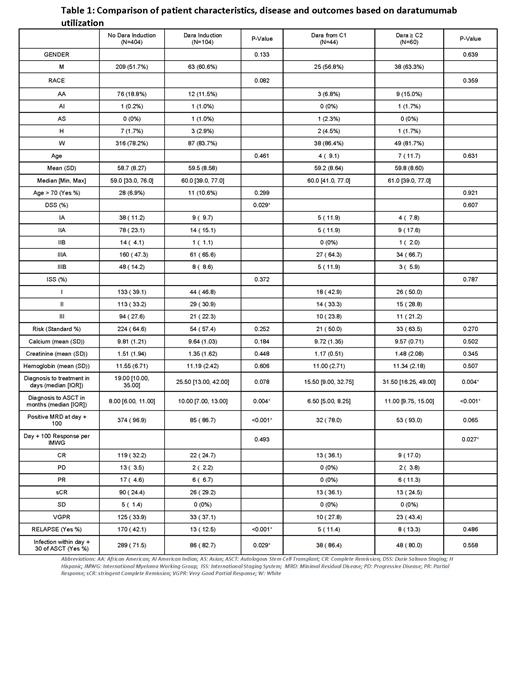Daratumumab is increasingly being used in the treatment of Multiple Myeloma (MM). However, patients with severe anemia (hgb < 7.5), severe hypercalcemia (serum calcium > 14), creatinine clearance < 30 ml/min, and patients aged > 70 years were excluded from the pivotal clinical trials that investigated first line daratumumab. Here we report how daratumumab is utilized in the treatment of real-world transplant eligible (TE) newly diagnosed multiple myeloma (NDMM) and its safety and efficacy in these vulnerable patient populations.
Method:
We conducted a retrospective chart review of all adult Multiple Myeloma patients who had autologous stem cell transplant (ASCT) at Vanderbilt University Stem Cell Transplant (VUSCT) program between January 2017 and April 2023. Descriptive statistics was used to summarize patient and disease characteristics. Patients with del 17p, t(4;14), t(14;16), 1q gain and 1p deletion were categorized as high risk. Fisher's exact test and Wilcoxon rank sum test was used to compare variables. Kaplan-Meir curves and log rank tests were used to compare PFS and OS. Binary logistic regression was used to evaluate patient and disease variables associated with daratumumab use. A p-value of <0.05 was considered statistically significant.
Result:
A total of 508 charts were reviewed. Out of 508, 104 patients had daratumumab containing induction regimen, including 44 patients who took daratumumab starting with the first cycle and 60 patients who had daratumumab added or regimen switched to include daratumumab as part of the induction regimen. Patient, disease, and outcomes of these patients is summarized in table 1. Additional 149 patients received daratumumab post-ASCT during subsequent relapses. Occurrence of relapse was the only variable associated with increased risk of death (HR=4.45, (95% CI: 1.94,10.06) with p-value=0.0003). Having standard cytogenetic risk was associated with decreased utilization of daratumumab in the induction regimen (OR=0.49, (95% CI: 0.27, 0897) with p-value of 0.02). Out of the 104 patients induced with daratumumab, patients who had daratumumab added after the first induction cycle had longer diagnosis to ASCT time when compared with patients who take daratumumab starting from cycle 1 of induction (table 1). Median progression free survival (PFS) and overall survival (OS) was not reached in either group.
Among populations of interest, there were 7, 2 African American (AA) and 5 white(W), 5 female (F) and 2 male patients, aged between 54 and 67 years, who had hemoglobin < 7.5 (range: 5.4 -7 g/dL) at diagnosis among the patients who had daratumumab containing induction regimen. All 7 of the patients had improvement in their hemoglobin post-induction and they remain in remission post-ASCT. Their hemoglobin trend is depicted on figure 1. There were 11 TE NDMM patients above age 70 (mean: 74, range: 71-77 years) who received daratumumab containing induction regimen. Although there was no statistically significant difference with the rest of the population, all patients had G3 infection within 30 days of ASCT, but no ICU admission or mortality with follow up of up to 39 months (average 18.45 months). We identified 10 patients with mean age of 53.8 years (range 45-65), 30% F, 40% AA, and 50% high-risk patients who had serum calcium >14 mg/dL. Only 1 patient had daratumumab containing induction regimen. Unfortunately, this patient died of disease progress 3 months after ASCT. Four other patients in this group also died between 3 and 54 months (mean: 18 months) from ASCT. Among 54 patients with creatinine > 2 at diagnosis, 8 patients, aged between 45 and 68 (mean = 58.37) years, mean creatinine of 4.95 (range 2.1-13.05) were induced with daratumumab containing regimen. Average creatinine dropped to 2.15 post-induction and 1.91 at 100 days post-ASCT. Three out of 8 died within 11months of ASCT (mean: 7 months) due to COVID infection in 1standard risk and disease progress in 2 high-risk patients.
Conclusion: Inclusion of daratumumab at the onset of induction is associated with shorter time between diagnosis and ASCT. Longer follow up is warranted to determine difference in PFS and OS among patients with early and late incorporation of daratumumab containing induction regimen. Our study suggests that daratumumab containing induction regimen is safe and effective for TE NDMM of all ages, including those with severe anemia and creatinine > 2 mg/dL.
Disclosures
Biltibo:BeiGene: Honoraria.


This feature is available to Subscribers Only
Sign In or Create an Account Close Modal